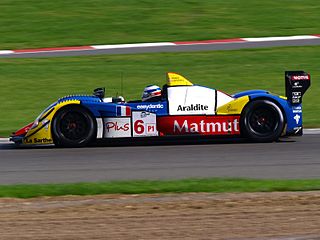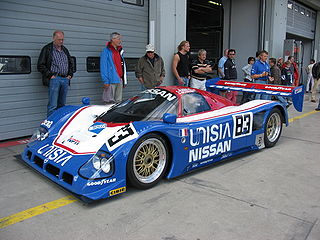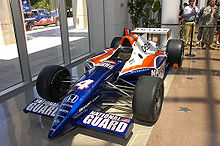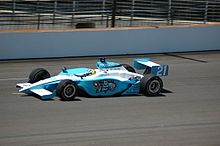
Panoz is an American manufacturer of sports automobiles founded in 1989 as Panoz Auto Development by Dan Panoz, son of Don Panoz. The company has also been extensively involved in professional racing, and designs, engineers and builds its own race cars. Panoz products have included the Panoz Roadster and AIV Roadster, the Panoz Esperante, and the Panoz Avezzano.
Chip Ganassi Racing, LLC (CGR), also sometimes branded as Chip Ganassi Racing Teams, is an American auto racing organization with teams competing in the NTT IndyCar Series, IMSA WeatherTech SportsCar Championship, FIA World Endurance Championship, and Extreme E. They have formerly competed in the NASCAR Cup and Xfinity Series, Global Rallycross Championship and the Rolex Sports Car Series. It was founded in 1990 by businessman and former racecar driver Chip Ganassi, from the assets of Patrick Racing to compete in the CART IndyCar World Series.
Gregory Ray is an American former race car driver.

The BMW V12 LMR is a Le Mans Prototype built for sports car racing from 1999 to 2000. The car was built through an alliance between BMW Motorsport and Williams F1, and was the successor to the failed BMW V12 LM of 1998. It is famous for earning BMW its only overall victory to date at the 24 Hours of Le Mans.

The Toyota GT-One is a racing car initially developed for Group GT1 rules, but later adapted into an LMGTP car. It raced in the 1998 and 1999 24 Hours of Le Mans.

Courage Compétition was a racing team and chassis constructor company now owned by Oreca, based in Le Mans, France near the Circuit de la Sarthe. It was founded by Yves Courage, a French race driver who ran hillclimbs before founding the company. Following the purchase of Courage by Oreca in 2007, Yves Courage has refounded the company as Courage Technology in 2010, attempting to develop electric racing cars.

The Nissan R390 GT1 was a racing car built in Atsugi, Japan. It was designed primarily to gain a suitable racing entry in the 24 Hours of Le Mans in 1997 and 1998. It was built to race under the grand touring style rules, requiring a homologated road version to be built. Therefore, the R390 was built originally as road car, then a racing version of the car was developed afterwards. Only one R390 road car was ever built and is stored at Nissan's Zama facility, although one of the race cars was later modified for road use. The road car was claimed to be capable of attaining a top speed of 354 km/h (220 mph). However, this claim has never been proven.

The Panoz DP01 is an open-wheel car that was produced by Élan Motorsport Technologies at Braselton, Georgia, United States. It was developed for use in the 2007 Champ Car World Series season, replacing the aging de facto-spec Lola chassis. The DP01 was introduced to the world at the 2006 Grand Prix of San Jose on July 28, 2006. Due to the February 2008 sale of Champ Car to the Indy Racing League, which uses its own spec equipment, the car is not currently used in a professional racing series in the United States. The final race for the car was the 2008 Grand Prix of Long Beach.

The IndyCar Series, currently known as the NTT IndyCar Series under sponsorship, is the highest class of regional North American open-wheel racing in the United States, which has been conducted under the auspices of various sanctioning bodies since 1920 after two initial attempts in 1905 and 1916. The series is self-sanctioned by its parent company, INDYCAR, LLC., which began in 1996 as the Indy Racing League (IRL) and was created by then Indianapolis Motor Speedway owner Tony George as a competitor to Championship Auto Racing Teams (CART). In 2008, the IndyCar Series merged with CART's successor, the Champ Car World Series and the history and statistics of both series, as well as those from its predecessors, were unified.

The Nissan R391 is a prototype racing car built by Nissan and their motorsports counterpart Nismo for competition at the 1999 24 Hours of Le Mans. It was a replacement for the R390 GT1, which was no longer legal in its production-based class.

Élan Motorsport Technologies is an American enterprise that serves as an umbrella company containing the race car engineering, development and manufacturing companies owned by American racing and automotive company conglomerate Panoz Motor Sports Group. Élan engineers, designs and builds Panoz-branded race cars and components. Since its founding it has also acquired several manufacturers, including famous Formula Ford builders Van Diemen and IndyCar Series constructor G-Force. Élan-built cars have successfully competed in the American Le Mans Series, Le Mans Series, IMSA Prototype Lites and various other championships, racing series and types of professional racing throughout the world. It designs, develops and manufactures full line race cars, i.e. chassis, bodies, components and engines for professional racing competition for a variety of segments and classes.

The Panoz LMP-1 Roadster-S was a Le Mans Prototype built for Panoz in 1999. The car was a successor to the Esperante GTR-1 which had competed in the Grand Tourer categories internationally. Following competition in the American Le Mans Series and at the 24 Hours of Le Mans until 2001, the car was replaced by the Panoz LMP07.

The Nissan R90C was a platform used for Group C racing cars built in 1990 by Nissan Motors for competition in World Sportscar Championship (WSC) based in Europe and the All Japan Sports Prototype Championship (JSPC). The cars based on the basic R90C platform would compete until 1993 before Nissan chose to withdraw from sports car racing, not returning until 1997. It won three JSPC championships and several significant endurance races during its career.

The DeltaWing is a racing car designed by British race car designer and engineer Ben Bowlby and debuted at the 2012 24 Hours of Le Mans. The entry was run under the Project 56 name, composed of Ben Bowlby (design), Dan Gurney's All American Racers (constructor), Duncan Dayton's Highcroft Racing and International Motor Sports Association owner Don Panoz. Nissan's NISMO division provided the engine in return for naming rights for part of 2012.

The G-Force GF09 is a racing car developed and produced by American manufacturer Élan Motorsport Technologies for Panoz, with original work having been performed by G-Force Technologies prior to its purchase by Panoz, for use in the IndyCar Series. A subsequent version that saw the greatest usage in IndyCar racing was the G-Force GF09B with the Panoz GF09C following.

The Nissan GT-R LM Nismo is a sports prototype racing car built by the Nissan Motor Company and their motorsports division Nismo. Designed for the Le Mans Prototype 1 (LMP1) regulations of the FIA World Endurance Championship and the 24 Hours of Le Mans, the GT-R LM was unique amongst Le Mans Prototypes at the time for utilizing a front mid-engine layout for its internal combustion engine, as opposed to the rear mid-engine layout used by nearly all other competitors in the category. It was Nissan's first prototype chassis since the R391 in 1999, although the company had developed engines in recent years. The car was branded after the Nissan GT-R road car and shares similar engine and drivetrain configurations, but is not related to the sports car. The GT-R LM Nismo program was announced on 23 May 2014, while the car was publicly shown for the first time in a Nissan commercial during Super Bowl XLIX on 1 February 2015. It was retired from competition at the end of 2015, after having only competed unsuccessfully at the 2015 24 Hours of Le Mans.
The Oldsmobile Aurora Indy V8 engine is a 3.5-liter to 4.0-liter, naturally-aspirated, V-8 Indy car racing engine, designed, developed and produced by Oldsmobile, for use in the IRL IndyCar Series; from 1996 to 2001. It is a variant of the Northstar engine.

The G-Force GF05 is a racing car developed and produced by American manufacturer Élan Motorsport Technologies for Panoz, with original work having been performed by G-Force Technologies prior to its purchase by Panoz, for use in the Indy Racing League. G-Force was once again a constructor for the second generation of IRL cars. G-Force would famously again visit victory lane in the Indianapolis 500 in 2000 with Chip Ganassi Racing's Juan Pablo Montoya. Élan purchased G-Force in 2002, and the production of the chassis was moved to Braselton for its final season. The second-generation G-Force IRL chassis competed in the series from 2000 to 2002.

The G-Force GF01 is an open-wheel racing car developed and produced by American manufacturer Élan Motorsport Technologies for Panoz, with original work having been performed by G-Force Technologies, prior to its acquisition by Panoz, for use in the Indy Racing League. G-Force was chosen to be one of the new constructors for the first generation of inaugural IRL cars, along with Dallara, and the existing Lola and Reynard chassis' used in the existing Champ Car Series. It's powerplant was the 4.0-liter, naturally-aspirated, Oldsmobile Aurora Indy V8 engine, running on methanol fuel, and making between 675–700 hp (503–522 kW), with a rev limit of 10,500 rpm. It was used in active competition between 1997 and 1999, and was succeeded by the GF05 in 2000. It famously won the 1997 Indianapolis 500, in the hands of, and being driven by Arie Luyendyk.



















